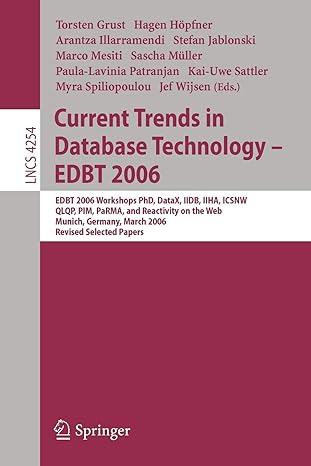Question
I would like some help in completing this exercise. Thank You public class ContactManager { /** * The instance variables are given below. Do NOT
I would like some help in completing this exercise. Thank You
public class ContactManager { /** * The instance variables are given below. Do NOT modify the two lines * */ private int nContacts; private Contact[] contacts;
/** * Implement the constructor of ContactManager class. In the constructor, * allocate an array of Contact. Use the nMaxContact as the length of the array * Initialize the nContacts to 0 in the constructor. * */ public ContactManager(int nMaxContact) { throw new UnsupportedOperationException("Remove this line and replace with your implementation."); }
/** * Given 4 String parameters, add a contact to the contacts array. Before adding * a contact to the array, do a parameter sanity check in this method. If the * array is full, or if first name or last name is null or an empty string, do * not add a contact but return false instead. Middle name can be left as null * or an empty String. Note that we allow adding duplicate contacts. * * If the name is acceptable, create a new contact and add the phone number to * the contact by calling the addPhoneNumber method of the Contact object. If * the method returns false, do not add the contact to the array and return * false (i.e., we discard the contact instantiated.) Otherwise, add the contact * to the array and return true. * * @param fName * @param lName * @param mName * @param phoneNumber * * @return a boolean value. See the description above */ public boolean addContact(String fName, String lName, String mName, String phoneNumber) { throw new UnsupportedOperationException("Remove this line and replace with your implementation."); }
/** * Given a Contact object, return the number of contacts with the identical name * (i.e., they have identical first, last, and middle name. If the input * parameter is null, return -1. * * For example, if the contacts array contains 10 contacts and there are 3 * elements have the same name, return 3. * * @return an int value. See the description above. */ public int countEqualContacts(Contact c) { throw new UnsupportedOperationException("Remove this line and replace with your implementation."); }
/** * This method returns the number of contacts (int) */ public int countContacts() { throw new UnsupportedOperationException("Remove this line and replace with your implementation."); } }
Step by Step Solution
There are 3 Steps involved in it
Step: 1

Get Instant Access to Expert-Tailored Solutions
See step-by-step solutions with expert insights and AI powered tools for academic success
Step: 2

Step: 3

Ace Your Homework with AI
Get the answers you need in no time with our AI-driven, step-by-step assistance
Get Started


